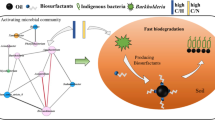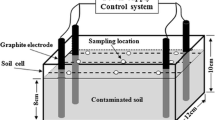Abstract
Electrokinetic-microbial remediation (EMR) has emerged as a promising option for the removal of polycyclic aromatic hydrocarbons (PAHs) from contaminated soils. The aim of this study was to enhance degradation of phenanthrene (Phe)-contaminated soils using EMR combined with biosurfactants. The electrokinetic (EK) remediation, combined with Phe-degrading Sphingomonas sp. GY2B, and biosurfactant obtained by fermentation of Pseudomonas sp. MZ01, degraded Phe in the soil with an efficiency of up to 65.1 % at the anode, 49.9 % at the cathode after 5 days of the treatment. The presence of biosurfactants, electricity, and a neutral electrolyte stimulated the growth of the degrading bacteria as shown by a rapid increase in microbial biomass with time. The electrical conductivity and pH changed little during the course of the treatment, which benefitted the growth of microorganisms and the remediation of Phe-contaminated soil. The EMR system with the addition of biosurfactant had the highest Phe removal, demonstrating the biosurfactant may enhance the bioavailability of Phe and the interaction with the microorganism. This study suggests that the EMR combined with biosurfactants can be used to enhance in situ bioremediation of PAH-contaminated soils.







Similar content being viewed by others
References
Mohan, S. V., Kisa, T., Ohkuma, T., Kanaly, R. A., & Shimizu, Y. (2006). Bioremediation technologies for treatment of PAH-contaminated soil and strategies to enhance process efficiency. Rev. Environ. Sci. Biotechnol., 5, 347–374.
Park, J.-Y., Lee, H.-H., Kim, S.-J., Lee, Y.-J., & Yang, J.-W. (2007). Surfactant-enhanced electrokinetic removal of phenanthrene from kaolinite. J Hazard Mater, 140, 230–236.
Saichek, R. E., & Reddy, K. R. (2003). Effect of pH control at the anode for the electrokinetic removal of phenanthrene from kaolin soil. Chemosphere, 51, 273–287.
Luo, Q., Zhang, X., Wang, H., & Qian, Y. (2005). The use of non-uniform electrokinetics to enhance in situ bioremediation of phenol-contaminated soil. J Hazard Mater, 121, 187–194.
Wick, L. Y., Mattle, P. A., Wattiau, P., & Harms, H. (2004). Electrokinetic transport of PAH-degrading bacteria in model aquifers and soil. Environ Sci Technol, 38, 4596–4602.
Da Rocha, U. N., Tótola, M. R., Pessoa, D. M. M., Júnior, J. T. A., Neves, J. C. L., & Borges, A. C. (2009). Mobilisation of bacteria in a fine-grained residual soil by electrophoresis. J Hazard Mater, 161, 485–491.
Lee, H.-S., Jahng, D., & Lee, K. (1999). Electrokinetic transport of an NAPL-degrading microorganism through sandy soil bed. Biotechnol Bioprocess Eng, 4, 151–153.
Lee, H. S., & Lee, K. (2001). Bioremediation of diesel-contaminated soil by bacterial cells transported by electrokinetics. J Microbiol Biotechnol, 11, 1038–1045.
Tiehm, A., Augenstein, T., Ilieva, D., Schell, H., Weidlich, C., & Mangold, K. M. (2010). Bio-electro-remediation: electrokinetic transport of nitrate in a flow-through system for enhanced toluene biodegradation. J Appl Electrochem, 40, 1263–1268.
Reddy, K. R. & Cameselle C. (2009). Electrochemical Remediation Technologies for Polluted Soils, vol 10. In X. Lu and S. Yuan (Ed.), Electrokinetic Removal of Chlorinated Organic compounds (pp. 219–234). John Wiley & Sons, NJ.
Saichek, R. E., & Reddy, K. R. (2004). Evaluation of surfactants/cosolvents for desorption/solubilization of phenanthrene in clayey soils. Int. J. Environ. Stud., 61, 587–604.
Laha, S., Tansel, B., & Ussawarujikulchai, A. (2009). Surfactant–soil interactions during surfactant-amended remediation of contaminated soils by hydrophobic organic compounds: a review. J Environ Manage, 90, 95–100.
Zhu, H., & Aitken, M. D. (2010). Surfactant-enhanced desorption and biodegradation of polycyclic aromatic hydrocarbons in contaminated soil. Environ Sci Technol, 44, 7260–7265.
Gomes, H. I., Dias-Ferreira, C., & Ribeiro, A. B. (2012). Electrokinetic remediation of organochlorines in soil: enhancement techniques and integration with other remediation technologies. Chemosphere, 87, 1077–1090.
Mulligan, C. N. (2009). Recent advances in the environmental applications of biosurfactants. Curr. Opin. Colloid Interface Sci., 14, 372–378.
Cheng, K. Y., Zhao, Z. Y., & Wong, J. W. (2004). Solubilization and desorption of PAHs in soil-aqueous system by biosurfactants produced from Pseudomonas aeruginosa P-CG3 under thermophilic condition. Environ Technol, 25, 1159–1165.
Park, J.-Y., Chen, Y., Chen, J., & Yang, J.-W. (2002). Removal of phenanthrene from soil by additive-enhanced electrokinetics. Geosci. J., 6, 1–5.
Kim, S. H., Han, H. Y., Lee, Y. J., Kim, C. W., & Yang, J. W. (2010). Effect of electrokinetic remediation on indigenous microbial activity and community within diesel contaminated soil. Sci Total Environ, 408, 3162–3168.
Lear, G., Harbottle, M. J., Sills, G., Knowles, C. J., Semple, K. T., & Thompson, I. P. (2007). Impact of electrokinetic remediation on microbial communities within PCP contaminated soil. Environ Pollut, 146, 139–146.
Mena, E., Villaseñor, J., Cañizares, P., & Rodrigo, M. A. (2014). Effect of a direct electric current on the activity of a hydrocarbon-degrading microorganism culture used as the flushing liquid in soil remediation processes. Sep Purif Technol, 124, 217–223.
Zhang, H., Guo, C. L., Lu, G. N., Yang, C., Dang, Z., & Wu, R. R. (2013). Screening and fermentation optimization of a biosurfactant-producing oil-degrading bacterium. J Agro-Environ Sci, 32, 2185–2191.
Tao, X.-Q., Lu, G.-N., Dang, Z., Yang, C., & Yi, X.-Y. (2007). A phenanthrene-degrading strain Sphingomonas sp. GY2B isolated from contaminated soils. Process Biochem, 42, 401–408.
Liang, X., Zhang, M., Guo, C., Abel, S., Yi, X., Lu, G., Yang, C., & Dang, Z. (2014). Competitive solubilization of low-molecular-weight polycyclic aromatic hydrocarbons mixtures in single and binary surfactant micelles. Chem Eng J, 244, 522–530.
Lear, G., Harbottle, M. J., van der Gast, C. J., Jackman, S. A., Knowles, C. J., Sills, G., & Thompson, I. P. (2004). The effect of electrokinetics on soil microbial communities. Soil Biol. Biochem., 36, 1751–1760.
Lysenko, L. L., & Mishchuk, N. A. (2009). Electrohydrodynamic method of pH regulation at soil decontamination. Colloids Surf A Physicochem Eng Asp, 333, 59–66.
Baek, K., Kim, D.-H., Park, S.-W., Ryu, B.-G., Bajargal, T., & Yang, J.-S. (2009). Electrolyte conditioning-enhanced electrokinetic remediation of arsenic-contaminated mine tailing. J Hazard Mater, 161, 457–462.
Chang, J.-H., & Liao, Y.-C. (2006). The effect of critical operational parameters on the circulation-enhanced electrokinetics. J Hazard Mater, 129, 186–193.
Pazos, M., Sanromán, M. A., & Cameselle, C. (2006). Improvement in electrokinetic remediation of heavy metal spiked kaolin with the polarity exchange technique. Chemosphere, 62, 817–822.
Kim, B.-K., Baek, K., Ko, S.-H., & Yang, J.-W. (2011). Research and field experiences on electrokinetic remediation in South Korea. Sep Purif Technol, 79, 116–123.
Aciego Pietri, J. C., & Brookes, P. C. (2009). Substrate inputs and pH as factors controlling microbial biomass, activity and community structure in an arable soil. Soil Biol. Biochem., 41, 1396–1405.
Thrash, J. C., & Coates, J. D. (2008). Review: direct and indirect electrical stimulation of microbial metabolism. Environ Sci Technol, 42, 3921–3931.
Pazos, M., Plaza, A., Martín, M., & Lobo, M. C. (2012). The impact of electrokinetic treatment on a loamy-sand soil properties. Chem Eng J, 183, 231–237.
Gonzini, O., Plaza, A., Di Palma, L., & Lobo, M. C. (2010). Electrokinetic remediation of gasoil contaminated soil enhanced by rhamnolipid. J Appl Electrochem, 40, 1239–1248.
Harbottle, M. J., Lear, G., Sills, G. C., & Thompson, I. P. (2009). Enhanced biodegradation of pentachlorophenol in unsaturated soil using reversed field electrokinetics. J Environ Manage, 90, 1893–1900.
Jackman, S. A., Maini, G., Sharman, A. K., Sunderland, G., & Knowles, C. J. (2001). Electrokinetic movement and biodegradation of 2,4-dichlorophenoxyacetic acid in silt soil. Biotechnol Bioeng, 74, 40–48.
Niqui-Arroyo, J.-L., & Ortega-Calvo, J.-J. (2007). Integrating biodegradation and electroosmosis for the enhanced removal of polycyclic aromatic hydrocarbons from creosote-polluted soils all rights reserved. No part of this periodical may be reproduced or transmitted in any form or by any means, electronic or mechanical, including photocopying, recording, or any information storage and retrieval system, without permission in writing from the publisher. J Environ Qual, 36, 1444–1451.
Chilingar, G. V., Loo, W. W., Khilyuk, L. F., & Katz, S. A. (1997). Electrobioremediation of soils contaminated with hydrocarbons and metals: progress report. Energy Sources, 19, 129–146.
Lageman, R., Clarke, R. L., & Pool, W. (2005). Electro-reclamation, a versatile soil remediation solution. Eng Geol, 77, 191–201.
Lee, G. T., Ro, H. M., & Lee, S. M. (2007). Effects of triethyl phosphate and nitrate on electrokinetically enhanced biodegradation of diesel in low permeability soils. Environ Technol, 28, 853–860.
Velasco-Alvarez, N., González, I., Damian-Matsumura, P., & Gutiérrez-Rojas, M. (2011). Enhanced hexadecane degradation and low biomass production by Aspergillus niger exposed to an electric current in a model system. Bioresour Technol, 102, 1509–1515.
Lee, H.-H., & Yang, J.-W. (2000). A new method to control electrolytes pH by circulation system in electrokinetic soil remediation. J Hazard Mater, 77, 227–240.
Breedveld, G. D., Hauge, A., Olstad, G., Briseid, T. (1995). Nutrient demand in bioventing of fuel oil pollution. Battelle Press, Columbus.
Hinchee, R. E., Miller, R. N., Johnson, P. C. (1995). In situ aeration: air sparging, bioventing, and related remediation process. Battelle Press, Columbus
Urum, K., & Pekdemir, T. (2004). Evaluation of biosurfactants for crude oil contaminated soil washing. Chemosphere, 57, 1139–1150.
Janek, T., Łukaszewicz, M., Rezanka, T., & Krasowska, A. (2010). Isolation and characterization of two new lipopeptide biosurfactants produced by Pseudomonas fluorescens BD5 isolated from water from the Arctic Archipelago of Svalbard. Bioresour Technol, 101, 6118–6123.
Xia, W.-J., Luo, Z.-B., Dong, H.-P., Yu, L., Cui, Q.-F., & Bi, Y.-Q. (2012). Synthesis, characterization, and oil recovery application of biosurfactant produced by indigenous Pseudomonas aeruginosa WJ-1 using waste vegetable oils. Appl Biochem Biotechnol, 166, 1148–1166.
Xia, W., Du, Z., Cui, Q., Dong, H., Wang, F., He, P., & Tang, Y. (2014). Biosurfactant produced by novel Pseudomonas sp. WJ6 with biodegradation of n-alkanes and polycyclic aromatic hydrocarbons. J Hazard Mater, 276, 489–498.
Gholami, M., Yousefi Kebria, D., & Mahmudi, M. (2014). Electrokinetic remediation of perchloroethylene-contaminated soil. Int J Environ Sci Technol, 11, 1433–1438.
Kaya, A., & Yukselen, Y. (2005). Zeta potential of soils with surfactants and its relevance to electrokinetic remediation. J Hazard Mater, 120, 119–126.
Acknowledgments
This study was supported by the National Natural Science Foundation of China (41101291), the Science and Technology Planning Project of Guangdong Province(2014A20217002), the National High Technology Research and Development Program of China (2012AA101403) and Ministry of Science and Technology of China (2012AA06A203). We thank our visiting professor, D. Barnes, for providing valuable comments on the manuscript.
Author information
Authors and Affiliations
Corresponding author
Rights and permissions
About this article
Cite this article
Lin, W., Guo, C., Zhang, H. et al. Electrokinetic-Enhanced Remediation of Phenanthrene-Contaminated Soil Combined with Sphingomonas sp. GY2B and Biosurfactant. Appl Biochem Biotechnol 178, 1325–1338 (2016). https://doi.org/10.1007/s12010-015-1949-8
Received:
Accepted:
Published:
Issue Date:
DOI: https://doi.org/10.1007/s12010-015-1949-8




